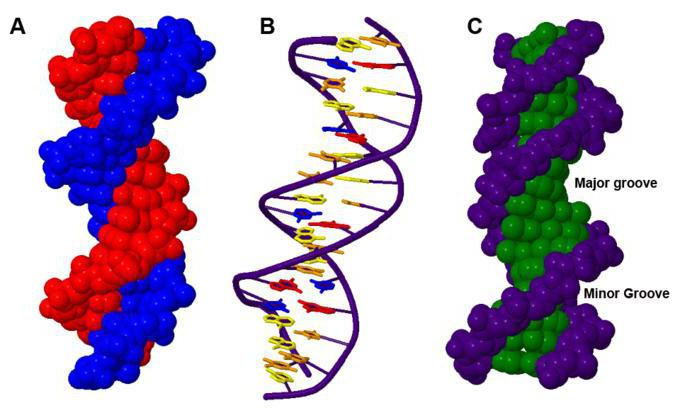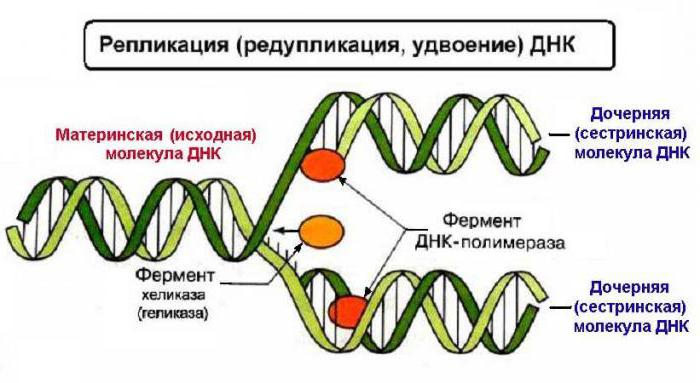Nucleic acids, especially DNA, are quite well known in science. This is explained by the fact that they are substances of the cell on which the storage and transmission of its hereditary information depends. DNA, discovered back in 1868 by F. Misher, is a molecule with pronounced acidic properties. The scientist isolated it from the nuclei of white blood cells - cells of the immune system. Over the next 50 years, studies of nucleic acids were carried out sporadically, since most scientists of biochemists considered proteins to be the main organic substances responsible for hereditary traits as well.
Since the decoding of the DNA structure by Watson and Crick in 1953, serious research has begun that has revealed that deoxyribonucleic acid is a polymer, and nucleotides serve as DNA monomers. Their types and structure will be studied by us in this work.
Nucleotides as structural units of hereditary information
One of the fundamental properties of living matter is the preservation and transmission of information about the structure and functions of both the cell and the entire organism as a whole. This role is played by deoxyribonucleic acid, and DNA monomers - nucleotides are a kind of "bricks", from which a unique construction of the substance of heredity is built. Consider what signs guided wildlife, creating a nucleic acid supercoil.
How nucleotides are formed
To answer this question, we need some knowledge from the field of chemistry of organic compounds. In particular, we recall that in nature there is a group of nitrogen-containing heterocyclic glycosides combined with monosaccharides - pentoses (deoxyribose or ribose). They are called nucleosides. For example, adenosine and other types of nucleosides are present in the cytosol of a cell. They enter into an esterification reaction with phosphoric acid molecules. The products of this process are nucleotides. Each monomer of DNA, and their four species, has a name, for example, guanine, thymine and cytosine nucleotide.
Purine DNA Monomers
In biochemistry, a classification is adopted that separates DNA monomers and their structure into two groups: for example, adenine and guanine nucleotides are purine. They contain derivatives of purine - an organic substance having the formula C 5 H 4 N 4 . The DNA monomer, a guanine nucleotide, also contains a purine nitrogen base connected to deoxyribose with an N-glycosidic bond in the beton configuration.
Pyrimidine nucleotides
Nitrogen bases, called cytidine and thymidine, are derivatives of the pyrimidine organic matter. Its formula is C 4 H 4 N 2 . The molecule is a six-membered planar heterocycle containing two nitrogen atoms. It is known that instead of thymine nucleotide in molecules of ribonucleic acid, such as rRNA, tRNA, mRNA, contains uracil monomer. During transcription, during the transfer of information from the DNA gene to the mRNA molecule, the thymine nucleotide is replaced by the adenine nucleotide, and the adenine nucleotide is replaced by uracil in the synthesized mRNA chain. That is, the following record will be fair: A - U, T - A.
Charguff Rule
In the previous section, we have already partially touched upon the principles of the correspondence of monomers in DNA chains and in the complex of mRNA. The well-known biochemist E. Chargaff established a completely unique property of deoxyribonucleic acid molecules, namely, that the number of adenine nucleotides in it is always equal to thymine, and guanine to cytosine. The main theoretical basis of the principles of Chargaff was the research of Watson and Crick, who established which monomers form a DNA molecule and what spatial organization they have. Another regularity deduced by Charguff and called the principle of complementarity indicates the chemical relationship of purine and pyrimidine bases and their ability to form hydrogen bonds when interacting with each other. This means that the arrangement of monomers in both DNA strands is strictly determined: so, opposite to the first DNA strand, only T can be located on the other and two hydrogen bonds arise between them. Opposite to the guanine nucleotide, only cytosine can be located. In this case, three hydrogen bonds are formed between the nitrogenous bases.

The role of nucleotides in the genetic code
To implement the protein biosynthesis reaction occurring in the ribosomes, there is a mechanism for translating information about the amino acid composition of the peptide from the mRNA nucleotide sequence into the amino acid sequence. It turned out that three adjacent monomers carry information about one of the 20 possible amino acids. This phenomenon is called the genetic code. In solving problems in molecular biology, it is used to determine both the amino acid composition of the peptide and to clarify the question: what monomers form the DNA molecule, in other words, what is the composition of the corresponding gene. For example, the AAA triplet (codon) in the gene encodes the phenylalanine amino acid in the protein molecule, and in the genetic code it will correspond to the UUU triplet in the mRNA chain.
The interaction of nucleotides in the process of DNA replication
As it was clarified earlier, structural units, DNA monomers are nucleotides. Their specific sequence in chains is a matrix for the synthesis of a deoxyribonucleic acid daughter molecule. This phenomenon occurs in the S-stage of cell interphase. The nucleotide sequence of a new DNA molecule is assembled on the mother chains under the action of the DNA polymerase enzyme, taking into account the principle of complementarity (A - T, D - C). Replication refers to matrix synthesis reactions. This means that the DNA monomers and their structure in the mother chains serve as the basis, that is, the matrix for its daughter copy.
Can the structure of the nucleotide change
By the way, let's say that deoxyribonucleic acid is a very conservative structure of the cell nucleus. There is a logical explanation for this: the hereditary information stored in the chromatin of the nucleus should be unchanged and be copied without distortion. Well, the cellular genome is constantly "under the gun" of environmental factors. For example, aggressive chemical compounds such as alcohol, medicine, radiation. All of them are so-called mutagens, under the influence of which any DNA monomer can change its chemical structure. Such bias in biochemistry is called point mutation. The frequency of their occurrence in the genome of the cell is quite high. Mutations are corrected by the well-functioning cell repair system, which includes a set of enzymes.

Some of them, for example, restriction enzymes, “cut out” damaged nucleotides, polymerases provide the synthesis of normal monomers, ligases “cross-link” the restored regions of the gene. If, for some reason, the above mechanism does not work in the cell and the defective DNA monomer remains in its molecule, the mutation is picked up by the processes of matrix synthesis and phenotypically manifests itself in the form of proteins with impaired properties, unable to perform the necessary functions inherent in cellular metabolism. This is a serious negative factor that reduces cell viability and shortens its life span.